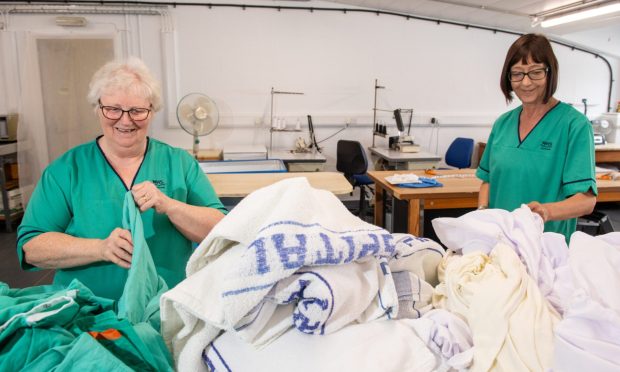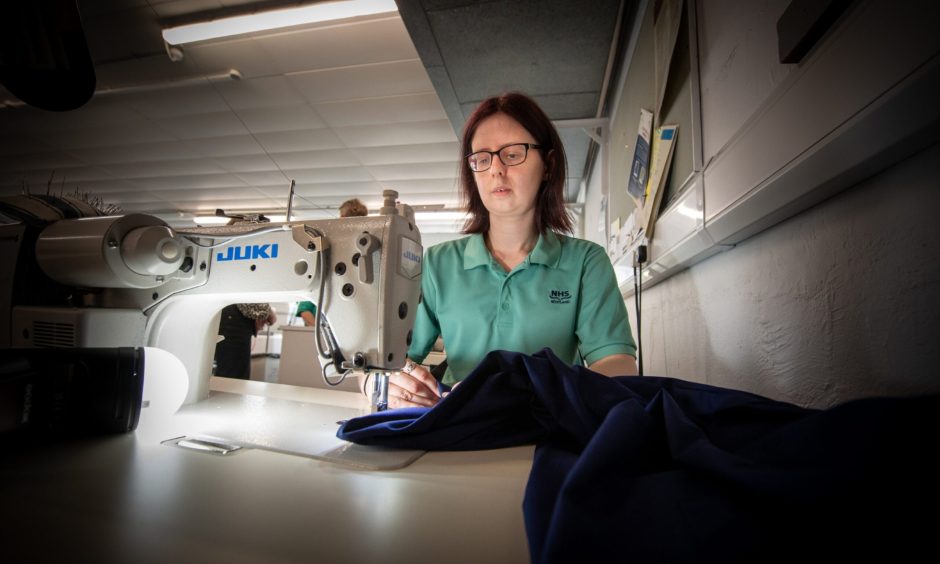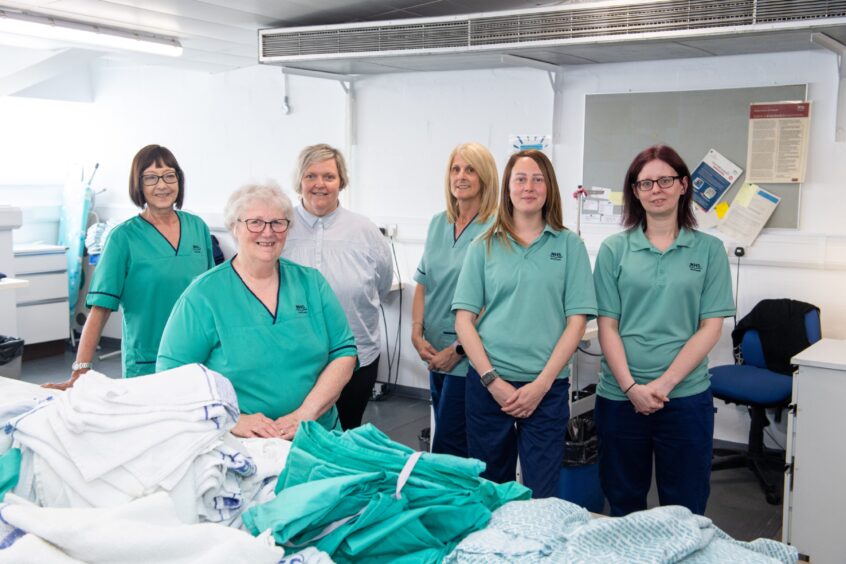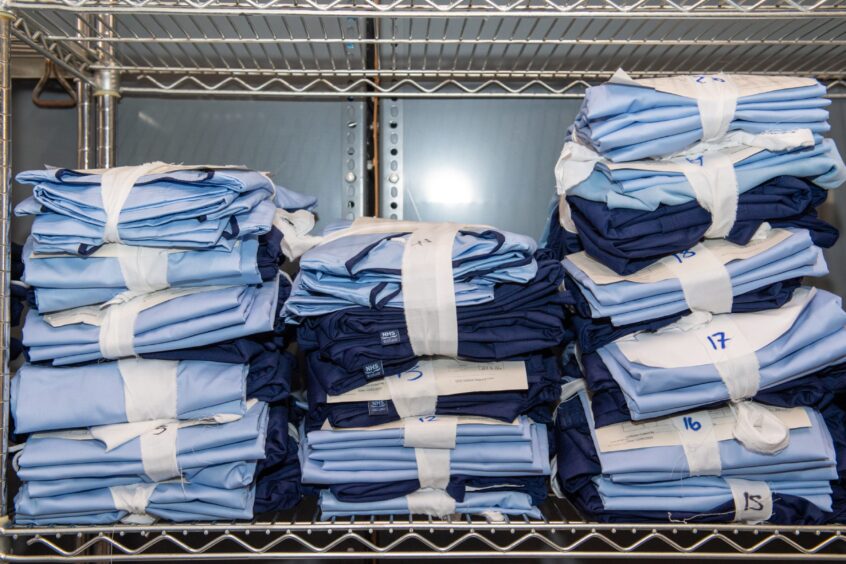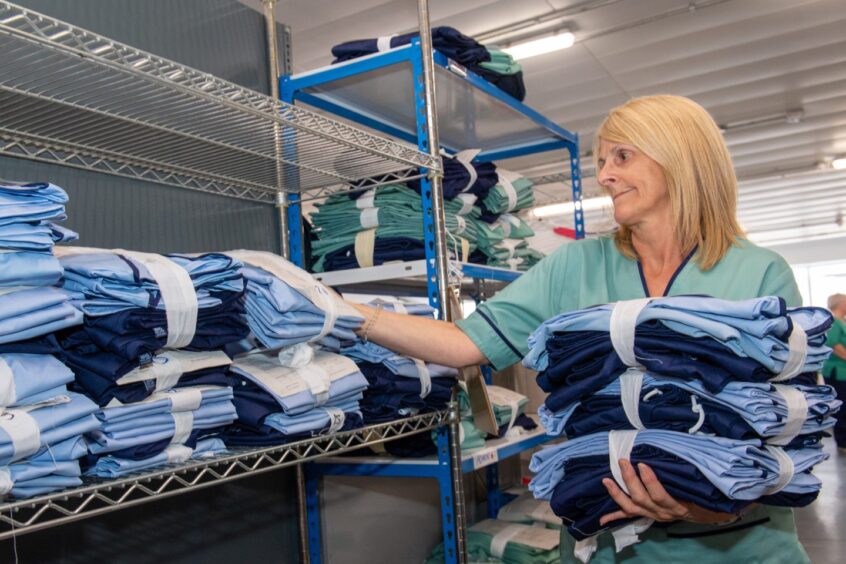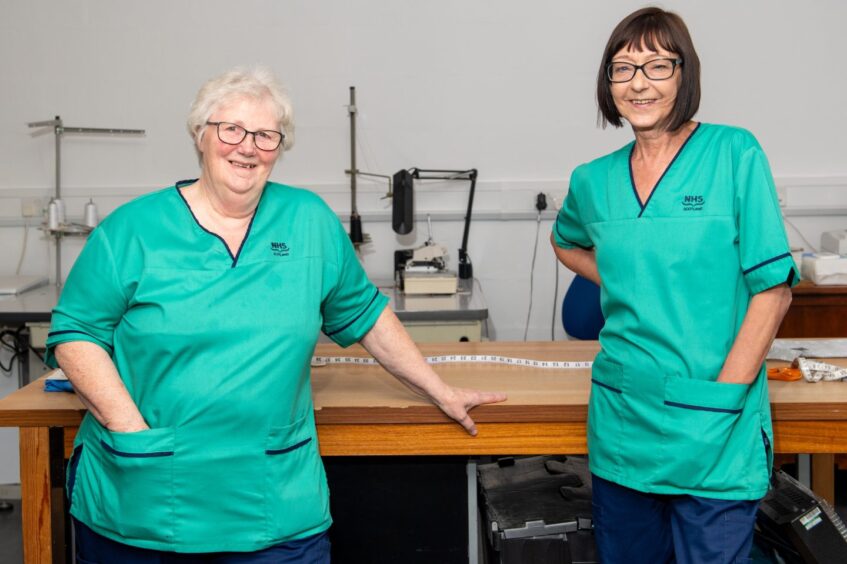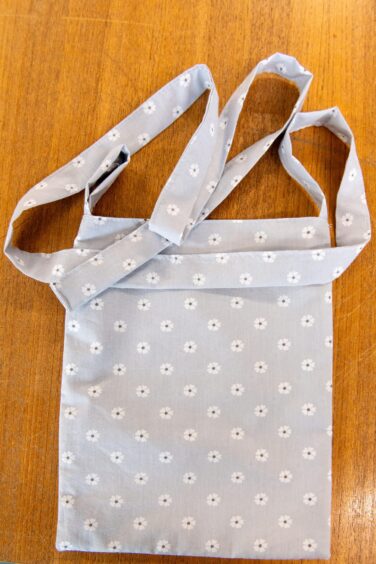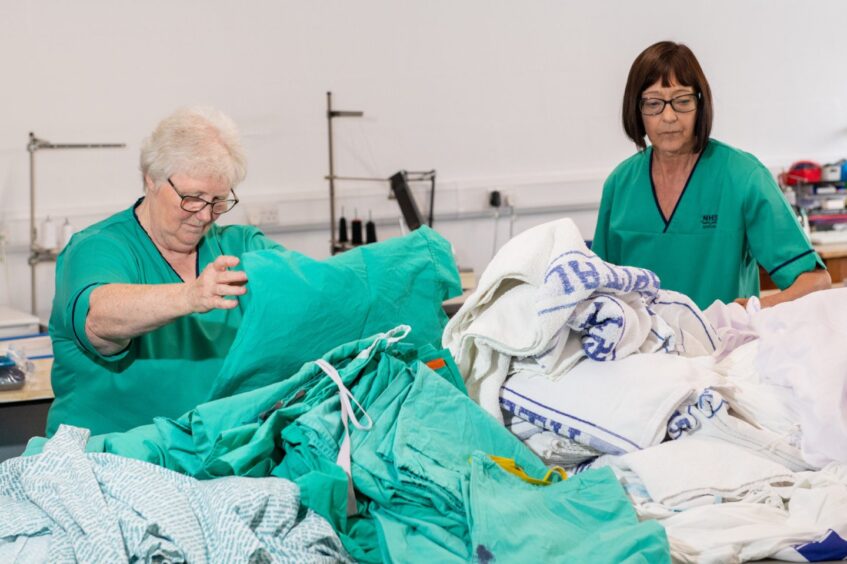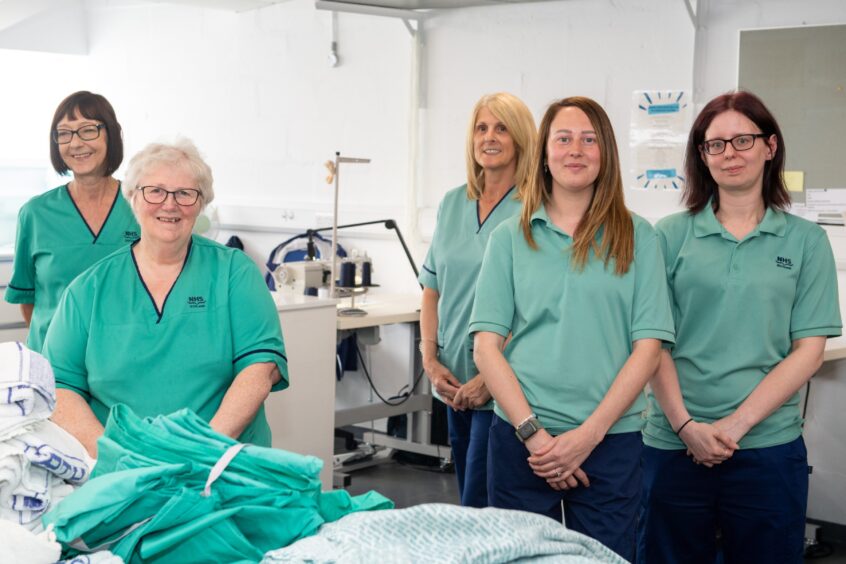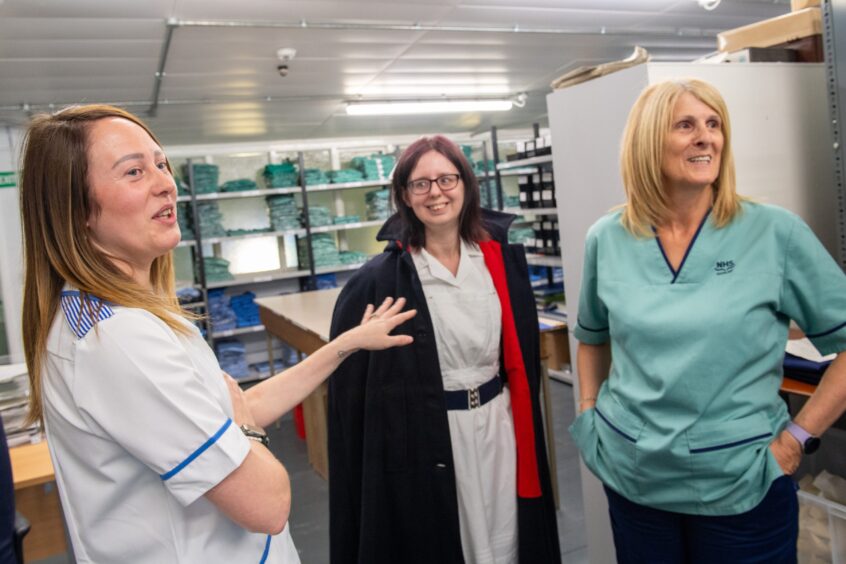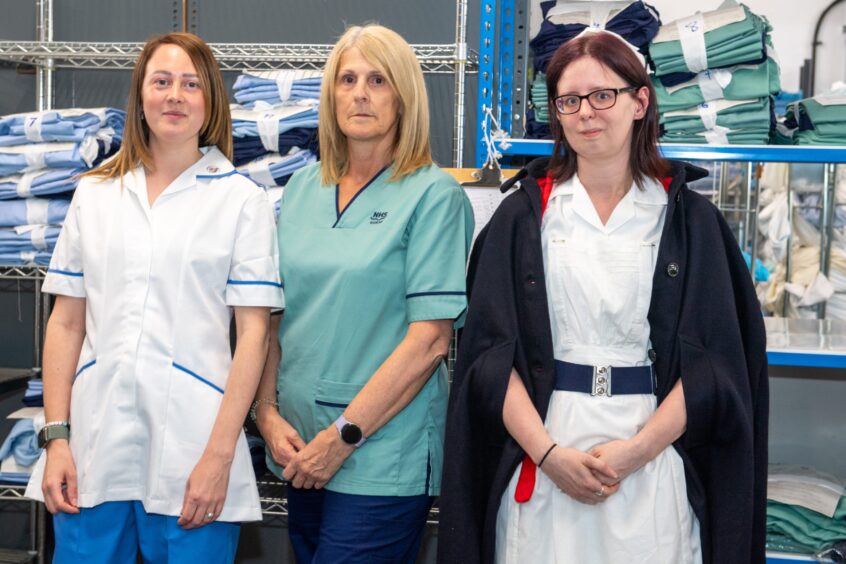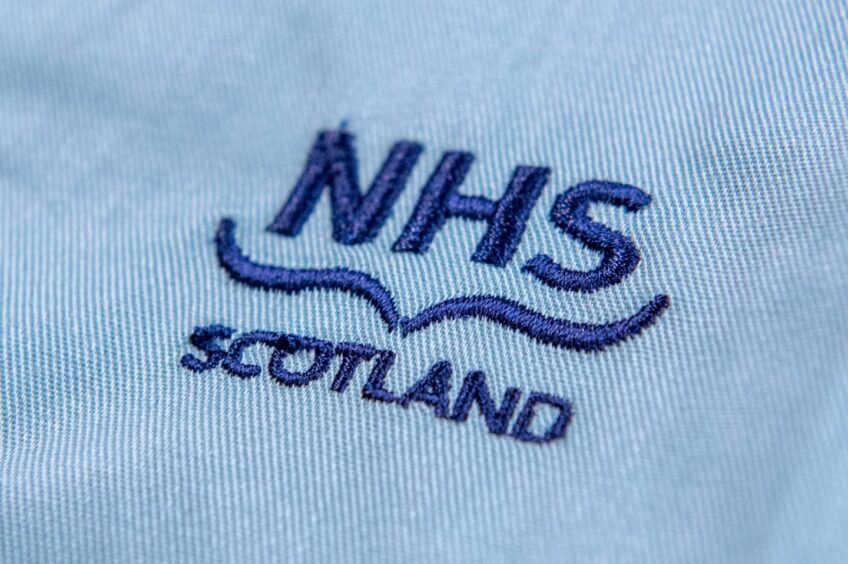It is the hidden engine room of NHS Grampian, where every staff member is fitted for their uniforms.
But the sewing room at Aberdeen Royal Infirmary is also a glimpse into the NHS’s past.
The second-floor space, just above the Aberdeen hospital’s huge laundry and decked out with cutting tables and sewing machines, is one of the last of its kind in Scotland — a holdout from when every hospital or community hospital had its own.
But as ideas such as reuse, repair and recycle come back into fashion, the sewing room is proving its worth all over again.
And saving NHS Grampian money at a time when its chief executive says it is facing a £77 million budget hole.
“It’s all about old-fashioned repair,” says Lynn Christie, who oversees the sewing room as ARI’s linen services manager.
The P&J has been given an exclusive look behind the sewing room scenes to find out exactly what happens in one of the busiest spots in the hospital.
Read on to find out:
- Why forgotten pens and biros are the sewing room’s biggest headache
- How staff fix clothes so they can be worn more comfortably by burns victims
- The time staff made a five-year-old cancer patient’s dream come true
- Why the sewing room has a large collection of old NHS uniforms, some dating back 50 years or more
ARI’s sewing room is the place to be for new starts
No one seems to know exactly why ARI still has a sewing room when most other hospitals don’t anymore.
But though the department is smaller than it used to be (ARI once had three sewing rooms) it benefits all NHS Grampian staff even before they start work.
While staff in other parts of the country must pick a uniform from the standard NHS sizes (extra small to 5XL), everyone who works for the health board is individually measured in the sewing room so they can have their uniform ready for when they start work.
It’s a massive undertaking — more than 2,000 staff join every year — but one that the sewing room takes pride in.
In fact, there’s only two main headaches around here.
The first is pens left in uniforms that then go through the laundry (“One biro pen can wipe out 100 items,” sighs Lynn).
And the second? People arguing over uniform colours.
“You wouldn’t believe the requests I’ve had around their expectations of the uniform provision due to the colour,” Lynn says. “People think they should be different colours to what they are.”
That’s mainly down to the 2011 decree by NHS Scotland that standardised uniforms across the country’s health service and brought in the tunic-style tops.
There were also rules on the colour of the uniform — for example, clinical staff in blue.
That blue comes in five different shades, depending on rank or job. Which is where the arguments stem from.
Making sense of the NHS’s colour rules
Luckily, the sewing room has a resident oracle on what colours go where.
Angela Ross has worked here for 26 years, spanning nine different uniform overhauls.
She started out as a patient helper but joined the sewing room team after the unit she worked in was closed. “I just took a chance,” she says.
She studied kilt making for four years at college in Aberdeen but claims she didn’t have too many practical skills when she joined.
Over the years, though, she’s learned everything about the job, helped by co-worker Maureen Kaczmarek, who’s been in the sewing room for 33 years.
Angela rattles off the different shades each NHS rank and job require, sounding like a Dulux swatch book.
Mediterranean Blue? That’s the Allied Health Professionals, or AHPs as Angela calls them.
Ocean Blue covers the healthcare scientists and dentists while Cornflower Blue is for registered nurses.
To the patients, it no doubt all looks the same. But to Angela — and to the staff themselves — the colours are an instant signifier.
Bringing joy to patients – and sewing room staff
Because ARI has a sewing room, staff around the hospital try to make the most of it.
That means Angela and the rest of the team spend a lot of time solving problems sent to them by other departments.
For example, there was the X-ray machine cover that was falling apart. Could the sewing room repair it?
Or the decontamination unit gowns that were repaired instead of spending the £55 each needed to replace the specialised clothing.
Another example of sewing room problem-solving are the boojee-looking chemotherapy medication bags made out of material salvaged from other jobs.
Plus, the burns patient clothes modified to make them more comfortable.
Some of it saves the already cash-strapped NHS money: the contaminated gown repair saved an estimated £8,000.
But as with the patterned drain bags, some of it simply makes a stay at ARI or other NHS Grampian hospital that little bit more joyful for patients.
On a few occasions, it even brings joy to the sewing room staff.
Angela vividly remembers the five-year-old girl with terminal cancer who had a bucket list wish to be a senior charge nurse for the day.
So Angela and the team put together a child-sized senior charge nurse uniform that the girl wore as she strode around the wards, clipboard in hand.
“It was quite sad,” says Angela, who made sure she was there to see her handiwork put to good use.
“We were all greeting, but it was so cute on her.”
A museum of uniforms from the NHS’s past
Angela’s job includes training the newer sewing room employees, some of whom joined during the department’s most tumultuous time in recent memory — Covid.
“It was busy,” says Natalie Luke, who remembers long, snaking queues out the door as staff lined up to pick up the uniform changes they needed during the Covid restrictions. “We were thrown in the deep end.”
Working conditions are a lot less frantic now, though Natalie and colleague Claire Prati say it still can get stressful when uniform demand peaks.
At the moment, the team is racing to fulfill a request for 95 uniforms for staff Rosewell House, an Aberdeen care home partly run by NHS Grampian.
“We’re 80% of the way there,” says manager Lynn.
But there’s always time for a bit of fun.
For the benefit of the P&J’s photographer, sewing room staff model a few nurses older-style nurses uniforms.
Lynn says the department often gets handed old uniforms that retiring or former staff find in the back of wardrobes and cupboards.
The ones that can be saved are kept in a sort of ad-hoc museum in the sewing room as a reminder of how styles and materials have changed.
Claire is dressed in one of the older ones — a nursing uniform from the 50s or 60s complete with woolen cloak.
“It’s a bit heavy,” says Claire. “I’m not sure I could work in this.”
Why the sewing room at ARI isn’t going anywhere
Lynn sees the sewing room at a vital cog in the NHS Grampian wheel.
“You can’t have a trained nurse on site without a proper uniform on,” she says. “We are all part of it.”
Meanwhile, she’s proud the sewing room is still around to save money. Her team are in the running for a Green Star Award, which recognises sustainability work across NHS Grampian.
And as for any suggestion the sewing room will one day disappear, another victim of NHS management cuts, Lynn has a simple response.
“They don’t realise they need us until they need us,” she says.
